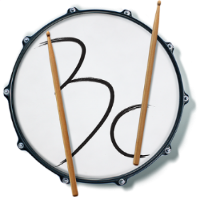Beats for Humanity: Drumming with Microtime [Part 3]
In the first two installments of this series (part 1, part 2), we explored how to create and play grooves that have a purposeful limp to them by utilizing an array of rhythmic grids. But, the ultimate purpose of this series is to use microtime to slide around the beats. This final installment demonstrates several tools and resources that will push your timekeeping abilities to their limit (and hopefully beyond).
Loose Interpretations
In the first installment, the grooves focused primarily on using 8th notes, triplets, 16th notes, and flams to create a somewhat loose feel (in a good way). We can combine all of these elements together to force some flexibility into a groove. While written notation is helpful for giving the reader an approximate idea of how a groove should sound, the context in which it’s played determines how exactly a groove should feel. The groove below is written using 8th and 16th notes, but the written rhythms have some wiggle room as to how they can be interpreted.
To start, Josh plays it with a literal interpretation - straight ahead with evenly spaced 8th and 16th notes. The groove then morphs to have a slightly swung feel. The off-16th kicks get pushed ever so slightly later in the beats, aligning somewhere between the 16th triplet and 32nd note grids. Finally, flams enter the mix, which really makes things feel more “drunk.”
Metronome Madness
Most drummers have some experience practicing with a metronome (and if you don’t, you should!), but only at a basic level - where the click plays directly on each beat. While there’s certainly nothing wrong with that, modern metronome apps offer all sorts of other tools that really take practicing time to a higher level.
One such function consists of the click shutting off for a certain number of beats. In this example, Kyle tests his internal timekeeping abilities along with a metronome that plays for 4 beats, and then stays silent for 4 beats. If your internal sense of time is really strong, you can get away with “stretching” the time a bit during the measures where the click is silent. However, getting right back onto the click is much easier said than done and has humbled many a drummer in the past.
Another way to use metronomes that enables drummers to bend time is to automate a click track in a DAW (digital audio workstation) that speeds up and slows down. It’s incredibly challenging to smoothly increase and decrease the tempo without any kind of jolt in the feel. And just the notion of constantly fluctuating speeds runs contrary to practically everything drummers are supposed to do! But it’s always good to take on a challenge like this to get yourself outside of your comfort zone. Check out Kyle and Josh putting forth an honest effort.
Jelly Loops
Another great way to get comfortable applying these microtime concepts is by practicing along with loops that are somewhat rhythmically ambiguous. With these loops, there are layers of rhythms, but not really any clearly defined beats or subdivisions. The sounds blend together, creating a sort of rhythmic gradient that allows for a wide range of interpretation.
Practicing along with a playlist of J Dilla beats is another fantastic exercise. Try to mimic the inflections and spacing of rhythms as closely as possible. You’ll find that the hihats often play a rhythm that’s somewhere in between steady 8th notes and a shuffle, and the bass drum lands all over the place and at varying dynamics.
To recap, in order to play off of the rhythmic grid, one must first master the rhythmic grid. As long as you have a strong internal sense of the underlying beat, whatever happens between one beat and the next doesn’t really matter as much. Microtime interpretations can be applied to grooves and fills in practically any style of music. With enough practice, you’ll be able to push and pull time as you wish!
Resources
Below are links to downloadable versions of all of the click tracks, loops, and sound designs used in the video demonstrations. There are several additional loops, and click tracks programmed to a much wider range of tempos than displayed above. It’s a lot of material, but that means you have lots of room to explore these concepts and apply your own creative spin!
Dropout Clicks - Click tracks where the metronome periodically goes silent.
Drift Clicks - Click tracks that gradually speed up and slow down.
Drift Sound Design - Loops that have no clearly defined rhythms.
Jelly Loops - Loops that make use of various rhythmic grids.


